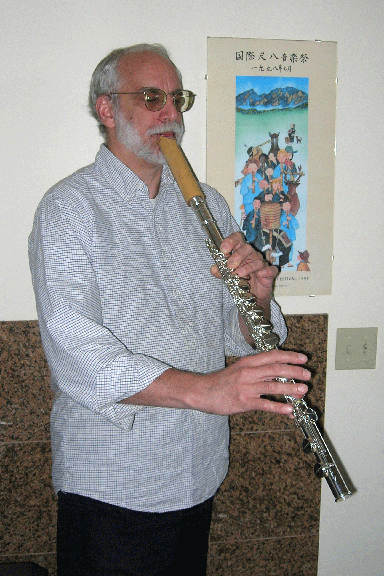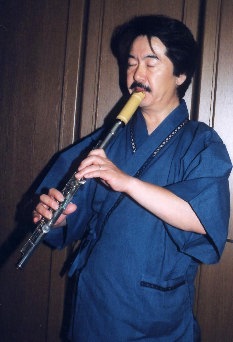SHAKULUTE

2004 New York Shakuhachi Festival
Invitation from Mr. Monty
Levenson
Click Here for detail | Biography|Original Works|
 205.5.27
205.5.27 
Monty's new alto shakulute
What a wonderful Instrument
that I have needed for a long time
March.14, 2003
from Monty Levenson's Homepage
On Monty's Website 
"Six of Original pieces" from CD
About this hybrid instrument
Never laugh at the picture of Shakulute after only a glance.
This is still the third instrument in Japan now (March, 2003).
On March in 2004, there are now six Shakulutes
in Japan, because I have two ones and four other people
have: John Kaizan Neptune, Bruce Huebner, a person in
Ehime prefecture and one in Engaru who is my student.
Maybe you can understand that Shakulute is a wonderful
instrument when you listen to the sound.
Anyway it has a very rich low sound which the flute doesn't have.
Of course, blowing goes straight down.
In addition, it is very easy to do tate-yuri, yoko-yuri, and mawashi-yuri.
And moreover, Shakulute is anexcellent musical instrument,
because it is not difficult to play the passage mixed with # and b(flat)
though it is not easy for us to perform such a passage with the shakuhachi.
The experience that I started playing the flute in the brassband
when I was a senior high student is made the most like this now.
How lucky I am! I appreciate honkyoku and jiuta
with the five-hole-
shakuhachi, and I enjoy harmony and rhythm when I play modern hougaku
with the seven-hole-shakuhachi, and besides
I can playpop music and my original music at will which was
composed for the Shakulute.
The fateful encounter with Mr. Monty Levenson came into blossom l
ike this. Nobody imagined this fate.
This hybrid instrument was named "Fulhachi-kun" in Japanese, and
Shakulute" in English by me.
The naming "Shakulute" is
recognized on Monty's homepage
.(You can link each page below.)
*****************************************
Please look at
(Links P&T) http://www.shakuhachi.com/L.ShakuhachiPlayers.html
(Main Menu) http://www.shakuhachi.com
*****************************************
☆ Reflection Message when they saw SHAKULUTE ☆
1. Mr. Hiroshi Yonezawa, a shakuhachi player of Nihon Ongaku-
shudan(Pro Musica Nipponia), wrote me:
"Long time ago, when 'Okuraro' appeared, it wasn't supported by
the players' needs, and didn't establish itself because
the time was not ripe at that time. But I think it isn't different now.
Some of the studio flute players copy how to play the shakuhachi,
and play their flutes in 'muraiki'.
But it is limited in its powerat the problem of the mouthpiece shape.
I guess that 'fluhachi-kun' will be first popular among the western
instruments players."
2. Mr.Suizan Maeda, the shakuhachi player, also wrote me:
"Yes, undoubtedly it is very different in the figure from the imagination
of the traditional shakuhachi.But the beginning of the new culture
may
be like this.
Probably if it becomes verypopular, it will be recognized as the really
another instruments from the traditional shakuhachi.
This instrument is the newest hybrid instrument born between the
western culture and the Japanese one as the result that the shakuhachi
is known to many people all over the world.
I think Japanese shakuhachiplayers may have psychological resistance.
But we should receive it as the apperance of the new culture,and should
never remove it.
It will be very interesting if it establish itself as the instrument
which
wasinfluenced by the shakuhachi, the Japanese instrument.

 205.5.27
205.5.27 
